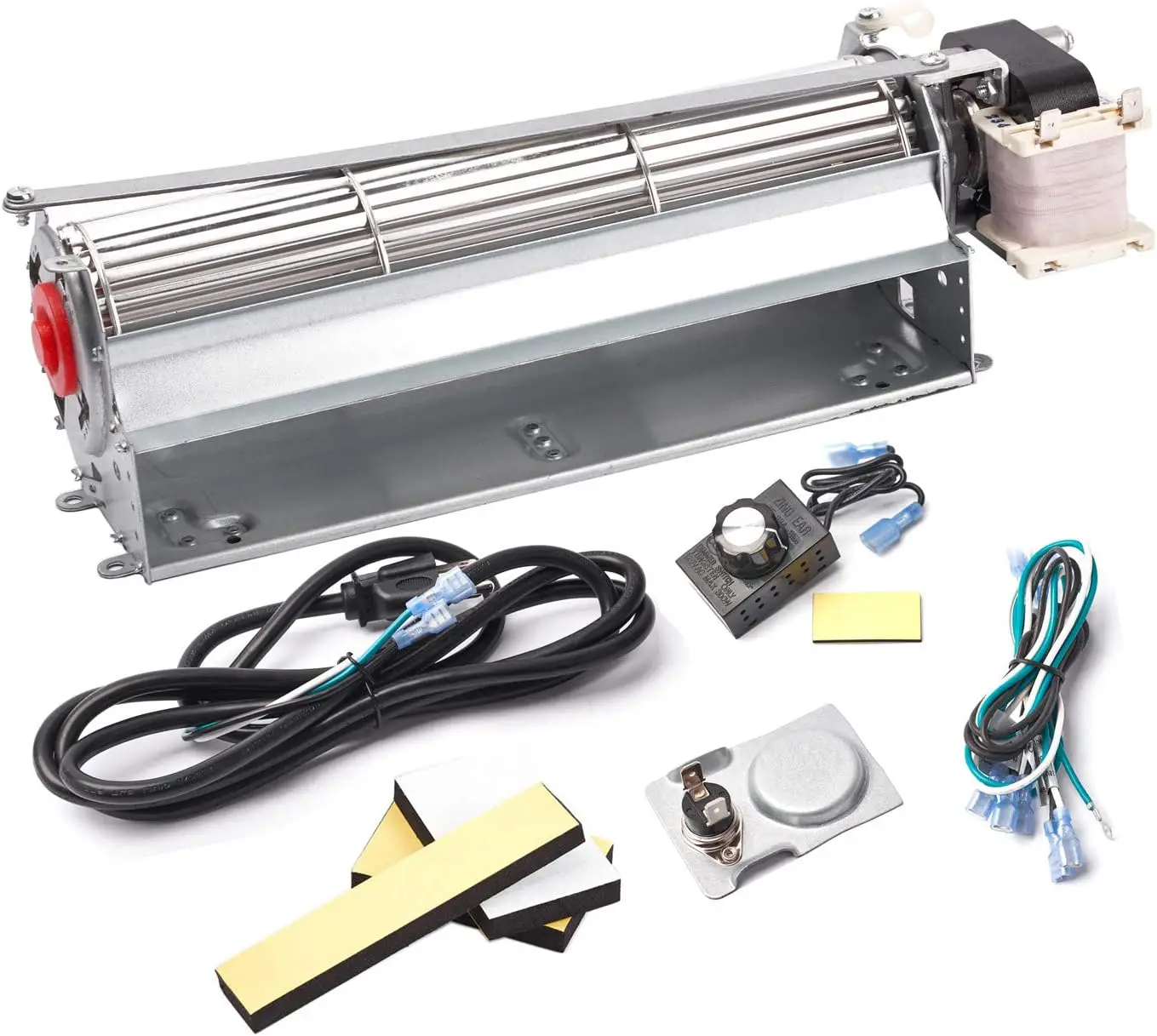Fireplace blower kits are an essential component for improving the efficiency of your fireplace. They circulate warm air more effectively throughout your space, making your home cozier during colder months. However, like any mechanical component, these kits have a lifespan and may need replacement to maintain optimal performance.
If you’ve noticed that your fireplace isn’t distributing heat as effectively as it used to, it might be time for a fireplace blower kit replacement.
In this blog post, we’ll explore the importance of a well-functioning blower kit, signs that indicate it needs replacing, and a step-by-step guide on how to choose and install a new one for several models include Heatilator fireplace blower kit replacement, Majestic, Lennox, Temco Fireplace, GFK4B, GFK4, FK4, GFK4A, GNBC33, NDV4236I, ND3933.
Whether you’re a seasoned DIY enthusiast or a first-time homeowner, understanding how to maintain this crucial part of your fireplace will ensure you enjoy a cozy and inviting atmosphere all winter long.
Fireplace Blower Kit Replacement
| Image | Product | Details | Price |
|---|---|---|---|
 |
Adviace Heatilator Fireplace Blower Kit Replacement | Heatilator, Majestic, Lennox, Temco Fireplace, GFK4B GFK4 FK4 GFK4A Fireplace Fan Blower Kit for Heatilator GNBC33,NDV4236I,ND3933 | Check Price |
About Adviace Replacement Fireplace Blower Kit
The Adviace Heatilator replacement fireplace blower kit versatile blower fits a range of popular fireplace models like Heatilator, Temco, Lennox, and Majestic, making it a convenient upgrade for almost any setup. What I love most is the adjustable airflow featureit lets me fine-tune the heat distribution while saving energy, thanks to the efficient 31-watt motor.
Installation is a breeze, with double-stick foam pads that not only make setup easy but also reduce noise for a quieter home environment.
Built to handle high temperatures up to 392°F, this blower is as durable as it is reliable, ensuring consistent performance during chilly evenings. With everything pre-wired and ready to go, it’s the kind of no-fuss solution every homeowner needs.
Key Features
- Fits Heatilator, Temco, Lennox, and Majestic fireplaces.
- Variable speed control with automatic thermostat.
- 31-watt motor delivers powerful airflow with low power consumption.
- Class H insulation rated up to 392°F.
- Includes pre-wired harness, thermostat, rheostat speed control, and 3-prong power cord for easy installation.
Compatible Models
- Heatilator Replacement Fireplace Blower Kit
- Heatilator GNBC33,NDV4236I,ND3933
- Majestic Replacement Fireplace Blower Kit
- Lennox Fireplace Blower Kit Replacement
- Temco Fireplace Blower
- GFK4B GFK4 FK4 GFK4A
Pros & Cons
| Pros | Cons |
|---|---|
| Universal fit for popular fireplace brands | May require professional installation for some models |
| Variable speed control for adjustable airflow | Slight learning curve for thermostat settings |
| Energy-efficient 31-watt motor | Not compatible with all fireplace models |
| Quiet operation with noise-reducing foam pads | Slightly higher price compared to standard blower kits |
| High durability with Class H insulation |
My Opinion
What really makes the Adviace Replacement Fireplace Blower Kit stand out for me is the combination of performance and convenience. The variable speed control lets you customize the airflow exactly how you want it whether you are looking for a cozy, gentle warmth or powerful heat distribution.
The noise reduction features are a bonus, as you can enjoy a quieter living space without the constant hum of a fan. Plus, knowing it’s built with durable materials that can withstand high temperatures gives me peace of mind.
While the price may be slightly higher than some generic options, the long-term benefits and ease of use make it totally worth it. If you want a reliable, efficient upgrade for your fireplace, this is the one to get!
Role of Fireplace Blower
A fireplace blower plays a crucial role in enhancing the efficiency and effectiveness of heating from a fireplace. Its primary function is to circulate warm air generated by the fire, improving heat distribution throughout the room. The blower pulls cool air from the space and forces it through channels adjacent to the firebox, allowing this air to absorb warmth as it moves around heated surfaces.
Once warmed, the air is expelled back into the living area, significantly increasing the overall heating efficiency. While a fireplace naturally radiates heat, a blower amplifies this effect by moving air more effectively, ensuring that less energy is wasted and maintaining a comfortable temperature.
Many modern blowers are equipped with temperature-activated switches that automatically turn on or off based on the ambient temperature, helping to regulate warmth without overheating.
Signs You Need to Replace Your Fireplace Blower Kit
Noise Issues or Unusual Sounds
If your blower kit is making loud or unusual noises, it could indicate worn-out bearings or a failing motor. This is a clear sign that a replacement is needed to avoid further complications.
Reduced Airflow or Inefficiency
When the blower no longer pushes enough air or struggles to distribute heat evenly, it’s time to consider a replacement. Decreased efficiency can lead to higher energy bills and reduced comfort.
Frequent Overheating or Motor Issues
A motor that overheats frequently or fails to start is another indicator that the blower kit is nearing the end of its lifespan.
Step-by-Step Guide to Replacing a Heatilator Fireplace Blower Kit
Essential Tools Checklist
- Screwdrivers (Phillips and flathead)
- Wrenches or socket set
- Needle-nose pliers
- Multimeter for electrical testing
- Vacuum cleaner or compressed air for cleaning
Materials Required for a Successful Installation
- New fireplace blower kit (compatible with your fireplace model)
- Replacement screws and brackets (if needed)
- Insulation or mounting materials
- User manual or installation guide
- Step 1: Turn Off the Power and Prepare the Area
- Before starting, switch off the power supply to the fireplace to prevent electrical hazards. Remove any decorative covers or panels to access the blower.
- Step 2: Remove the Existing Blower Kit
- Disconnect the old blower kit by unscrewing the mounting brackets and unplugging any wiring. Carefully slide the blower out of its housing.
- Step 3: Clean the Interior of the Fireplace
- Use a vacuum or compressed air to clean dust and debris from the fireplace interior. This ensures smooth operation and prevents clogging of the new blower.
- Step 4: Install the New Blower Kit
- Follow the manufacturer’s instructions to position the new blower kit. Secure it with mounting brackets and connect the wiring. Ensure all connections are tight and insulated properly.
- Step 5: Test the New Installation
- Restore the power and test the new blower. Check for proper airflow, noise levels, and functionality. Make adjustments if necessary.
Hiring a professional ensures a precise and safe installation. Professionals have the expertise to handle complex wiring and mounting tasks, reducing the risk of errors. However, it may come at a higher cost compared to a DIY approach.
DIY installation can save money, but it requires time, effort, and basic technical skills. Professional installation typically costs between $100 and $300, depending on the complexity of the job.
Tips for Choosing the Right Replacement Blower Kit
Not all blower kits are universal. It’s crucial to verify compatibility with your fireplace model. Consult your fireplace manual or manufacturer to identify the specific kit designed for your unit.
The noise level of a blower kit can greatly affect your comfort. Option for kits with quiet motors and efficient operation. Models with noise-reducing features, such as rubber gaskets, are ideal for maintaining a serene ambiance.
Choose a blower kit with energy-efficient features to reduce electricity usage. Additionally, ensure the kit comes with a good warranty to protect against potential defects or malfunctions.
Common Issues After Replacement and How to Fix Them
- Blower Not Functioning After Installation
- If the new blower fails to start, check the power connection and ensure all wires are properly attached. Use a multimeter to test the electrical circuit for any faults.
- Persistent Noise Problems
- Noise issues may arise from improper installation or loose components. Recheck the mounting brackets and ensure the blower is aligned correctly within its housing.
- Airflow Issues Post-Replacement
- Airflow is insufficient, verify that the blower’s settings are correctly adjusted and that there are no blockages in the fireplace or ductwork.
Fireplace Blower Common Issues & Fixes
1. Decreased Air Flow
- Issue: Reduced hot air output due to dust and debris buildup.
- Fix: Clean the vents using a wet/dry vacuum. If airflow remains low, use a long-handled brush to remove additional debris or clean the motor if it’s clogged with dust.
2. Blower Does Not Turn On
- Issue: The blower fails to activate after use.
- Fix: Check the control panel settings for accuracy. Inspect for corrosion or damage on connections and wires. Replace any damaged wiring. If the blower still doesn’t work, the motor may need replacement.
3. Blower Keeps Tripping Circuits
- Issue: The circuit breaker trips frequently when the blower is in use.
- Fix: Ensure that the electrical system can handle the blower’s power requirements. Upgrading the circuit panel may be necessary, or consult an electrician if issues persist.
4. Wiring Issues
- Issue: Loose, frayed, or corroded wires can lead to operational failures.
- Fix: Inspect the wiring harness for any visible damage. If found, repair or replace the faulty wires. Bypass any defective accessories like speed controllers or thermostats to confirm functionality.
5. Noisy Operation
- Issue: Rattling or unusual sounds during operation.
- Fix: Check for loose screws or brackets on the blower motor and housing. Tighten any loose components to eliminate noise.
FAQs
What is the average lifespan of a fireplace blower kit?
A well-maintained fireplace blower kit typically lasts between 8 to 10 years, depending on usage and environmental factors.
Can I replace the blower kit without turning off the power?
No, turning off the power is essential to avoid electrical hazards during the replacement process.
How much does a typical replacement kit cost?
The cost of a replacement blower kit ranges from $50 to $200, depending on the model and features.
Is professional installation necessary for all blower kits?
No, many kits are designed for easy DIY installation. However, professional installation is recommended if you’re uncomfortable with electrical work.
What should I do if the new blower doesn’t fit my fireplace?
Check the compatibility of the blower kit with your fireplace model. If there’s a mismatch, contact the manufacturer or retailer for guidance or exchange options.
Affiliate Disclosure: Fireplaceadviser.com is a participant in the Amazon Services LLC Associates Program. We may earn a commission when you click on certain links on this site and purchase.

Hello!! I am Jamal Khan. I often fix my home electric heaters and gas stove problems and research the common issues in the heating units to improve my knowledge and expertise. The aim of establishing fireplaceadviser.com is to share my expertise and knowledge with my audience.












